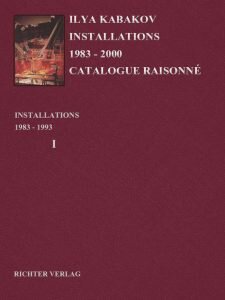The Untalented Artist
YEAR: 1988
CATALOGUE NUMBER: 17
NOTES
See Installation “Ten Characters,” Catalog No 15
PROVENANCE
The artist
Collection John L. Stewart, New York
EXHIBITIONS
New York, Ronald Feldman Fine Arts
Ten Characters 30 Apr 1988 — 4 Jun 1988
London, Institute of Contemporary Art
Ilya Kabakov. The Untalented Artist and Other Characters at the ICA London 23 Feb 1989 — 23 Apr 1989
Zürich, Kunsthalle Zürich
Das Schiff – Die Kommunalwohnung, Zwei Installationen von Ilya Kabakov 2 Jun 1989 — 30 Jul 1989
Washington, Hirshhorn Museum and Sculpture Garden
Directions. Ilya Kabakov. Ten Characters 7 Mar 1990 — 3 Jun 1990 (as part of No 15, Ten Characters)
DESCRIPTION
A large hall of old Empire style architecture has been transformed into an exhibition space, in much the same way that old estates were turned into new clubs in Russia. But this exhibit is not in a club of the beginning of the 20th century, with its pathos of the ‘enlightenment of the masses’ and ‘movement toward the future,’ but rather an exhibit from the end of the 1950’s or beginning of the 1960’s, when all ‘cultural events’ had turned into dead, unnecessary ritual, frozen in eternal solemnity. There is a long red carpet on the floor, chairs along the walls.
There are red vertical runners hanging between the paintings to separate them. Some runners bear inscriptions about the ‘significance and benefit of culture,’ its ‘role in the building of socialism,’ etc. The paintings are hung on the walls in an orderly, symmetrical ‘museum-like’ fashion. But it is precisely this museum-like, tranquil, contemplative state that is absent from the exhibit. Everything is scorched by the atmosphere of ideological benefit, the ‘education of the people via art.’
All kinds of texts (commentaries) are hanging both near the paintings and apart from them, explaining how the ‘simple people’ should understand the art exhibited here. An atmosphere of official, boring and importunate festivity reigns in everything.
ARTIST`S COMMENTS
I graduated from art school (I wound up in it accidentally) in Moscow, and then immediately after that, from the art institute. Hence I received an elementary and higher ‘art’ education, and although I graduated from the institute as a graphic artist, I could paint or, as they said then, I could ‘do painting.’ The education, both in school and in the institute, continued the traditions of Russian art education of the 19th Century, i.e., it was strictly academic. We studied anatomy, perspective, we drew from plaster molds, still-lifes, and then from live models: portraits, nudes. In the summer during our individual practicum we also drew portraits and figures, but this time ones that already existed in nature. All the students were immersed in studying nature, in complex, agonizing professional tasks: how to construct an object in space, the balance between light and reflection, how to convey volume on a plane, what is a pictorial resolution and how is it connected to the precise drawing…
We were surrounded at exhibits by a multitude of artistic production in the realistic manner, represented along the entire ‘pyramid’ of the classical hierarchy: religious, now ‘revolutionary’ painting with the participation of leaders like Lenin at the Podium, Stalin at the Congress. And everything else along the scale from there downward: battle paintings, historical ones. And even lower in the genre hierarchy: portraits (outstanding workers, collective farm workers, pilots, steel founders), landscapes (of the Motherland, of collective farm fields), still-lifes demonstrating the abundance of Soviet life, or ‘Russian paintings’ (dark bread, a salt-dip, mushrooms), and finally, at the lower end of the scale, there were touching, sentimental ‘genre’ scenes of happy family life, children’s play…
The entire artistic world of the Soviet Union, from famous academics to the copiers’ guild (there was such a guild, which copied famous paintings and disseminated them everywhere), adhered to the singular style of Socialist Realism, and all of us finishing our studies were supposed to flow into this already well-articulated system and take up our own shelf in the ‘wall unit’ that had been drawn above us. In this sense, in essence, what kind of an artist an individual happened to be was entirely insignificant: whether he was highly talented and produced the best work in the row, or whether he was ungifted and produced works of mediocre quality. The quality of the artistic system itself, its canons, would neither improve nor suffer because of this.
But the question of talent was nevertheless essential for the subjective well-being of the artist. I was untalented. I did not have any abilities for this endeavor, I didn’t like it. I did not have a feel for color, lay-out, composition, balance, and I didn’t see the whole, etc. But gradually, during the process of studying, I acquired the skills to imitate that which was being done around me, that which my teachers de – manded. I become a rabbit who, not hearing the music, learned, trained myself in a specific rhythm to play the drum ‘so that something similar to what was expected would result.’ And if everything went as it was supposed to, then walking shoulder to shoulder with my classmates, I, in my own turn, would wind up on the level of the artistic hierarchy allotted to me, for after all, everything was determined beforehand. What’s the difference, in essence, who you perceive yourself to be – ‘a talent’ or not? Sticking together, your generation, your group, would replace the previous one like one wave after another in the boundless sea of ‘Soviet fine art, the most progressive art in the world …’
Images
Literature







